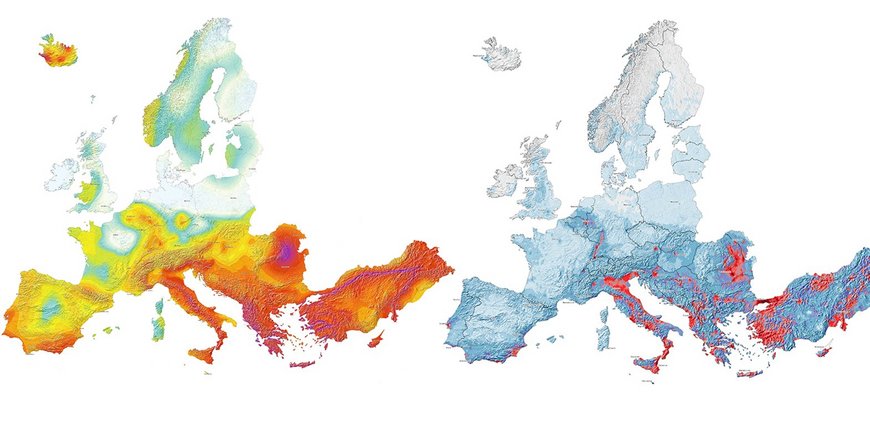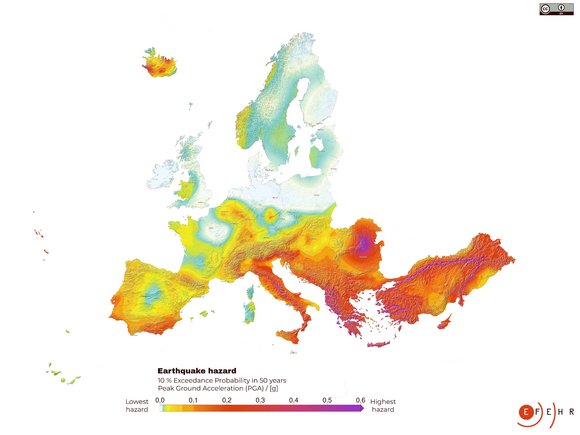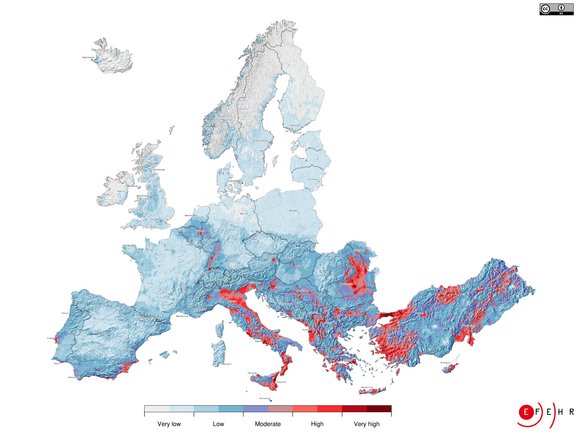Joint press release with the EFEHR Consortium (European Facilities for Earthquake Hazard and Risk)
Summary
During the 20th century, earthquakes in Europe accounted for more than 200,000 deaths and over 250 billion Euros in losses. Comprehensive earthquake hazard and risk assessments are crucial to reducing the effects of catastrophic earthquakes. The newly released update of the earthquake hazard model and the first earthquake risk model for Europe are the basis for establishing mitigation measures and making communities more resilient. They significantly improve the understanding of where strong shaking is most likely to occur and what effects future earthquakes in Europe will have. The development of these models was a joint effort of seismologists, geologists, and engineers across Europe with the contribution of members from the GFZ German Research Centre for Geosciences (GFZ). The research has been funded by the European Union’s Horizon 2020 research and innovation programme.
Background earthquake hazard and risk
Earthquakes cannot be prevented nor precisely predicted, but efficient mitigation measures informed by earthquake hazard and risk models can significantly reduce their impacts. The 2020 European Seismic Hazard and Risk Models offer comparable information on the spatial distribution of expected levels of ground shaking due to earthquakes, their frequency of occurrence as well as their potential impact on the built environment and on people’s wellbeing. To this aim, all underlying datasets have been updated and harmonised – a complex undertaking given the vast amount of data and highly diverse tectonic settings in Europe. Such an approach is crucial to establish effective transnational disaster mitigation strategies that support the definition of insurance policies or up-to-date building codes at a European level (e.g., Eurocode 8) and at national levels. In Europe, Eurocode 8 defines the standards recommended for earthquake-resistant construction and retrofitting buildings and structures to limit the impact due to earthquakes. Open access is provided to both, the European Seismic Hazard and Risk Models, including various initial components such as input datasets.
The updated earthquake hazard model benefits from advanced datasets
Earthquake hazard describes potential ground shaking due to future earthquakes and is based on knowledge about past earthquakes, geology, tectonics, and local site conditions at any given location across Europe. The 2020 European Seismic Hazard Model (ESHM20) replaces the previous model of 2013.
The advanced datasets incorporated into the new version of the model have led to a more comprehensive assessment. Consequently, ground shaking estimates have been adjusted in comparison to the previous 2013 European model. In some regions, such as Germany, lower estimates are found, which is consistent with the most recent German seismic hazard model developed by GFZ (Grünthal et al., 2018). In other regions like western Turkey, Greece, Albania, Romania, southern Spain, and southern Portugal, however, higher ground shaking estimates have increased. The updated model also confirms that Turkey, Greece, Albania, Italy, and Romania are the countries with the highest earthquake hazard in Europe, followed by the other Balkan countries. But even in regions with low or moderate ground shaking estimates, damaging earthquakes can occur at any time.
Furthermore, specific hazard maps from Europe’s updated earthquake hazard model will serve for the first time as an informative annex for the second generation of the Eurocode 8. Eurocode 8 standards are an important reference to which national models may refer. Such models, when available, provide authoritative information to inform national, regional, and local decisions related to developing seismic design codes and risk mitigation strategies. Integrating earthquake hazard models in specific seismic design codes helps ensure that buildings respond appropriately to earthquakes. These efforts thus contribute to better protect European citizens from earthquakes.
Main drivers of the earthquake risk are older buildings, high earthquake hazard, and urban areas
Earthquake risk describes the estimated economic and humanitarian consequences of potential earthquakes. In order to determine the earthquake risk, information on local soil conditions, the density of buildings and people (exposure), the vulnerability of the built environment, and robust earthquake hazard assessments are needed. According to the 2020 European Seismic Risk Model (ESRM20), buildings constructed before the 1980s, urban areas, and high earthquake hazard estimates mainly drive the earthquake risk.
Although most European countries have recent design codes and standards that ensure adequate protection from earthquakes, many older unreinforced or insufficiently reinforced buildings still exist, posing a high risk for their inhabitants. The highest earthquake risk accumulates in urban areas, many of which have a history of damaging earthquakes, such as the cities of Istanbul and Izmir in Turkey, Catania and Naples in Italy, Bucharest in Romania, and Athens in Greece. In fact, these four countries alone experience almost 80% of the modelled average annual economic loss of 7 billion Euros due to earthquakes in Europe.
The potential impact of earthquakes in a moderate seismicity area like Germany can also be significant because of the high exposure, i.e. regions with a large number of buildings, particularly those of high economic value. The German average annual economic loss is estimated to 260 million euros, but losses from individual events may be significantly higher. If the Roermond (1992) earthquake were to occur today the ESRM20 model predicts an average of 400M EUR of economic loss for the German territory.
Developing themodels is a joint effort – the role of GFZ
A core team of researchers from different institutions across Europe, including GFZ worked collaboratively to develop the first openly available Seismic Risk Model for Europe and to update Europe’s Seismic Hazard Model. They have been part of an effort that started more than 30 years ago and involved thousands of people from all over Europe. These efforts have been funded by several European projects and supported by national groups over all these years.
Scientists from GFZ have played a major role in the development of the ESHM20 and ESRM20, contributing three critical components of the models. The first contribution is new catalogue of earthquakes for the Europe from the beginning of the 20th century to the present day (PI Dr. Graeme Weatherill). This catalogue assembles earthquake data from dozens of data sources and seismic recording networks around Europe, harmonising them into a common reference catalogue from which the ESHM20 has derived statistics of earthquake recurrence.
The second major contribution is a complete pan-European model to predict ground shaking (PI. Prof. Fabrice Cotton). This builds on recent, rapidly expanding databases of ground motion observations in Europe and incorporates state-of-the-art modelling techniques to predict the distribution of strong ground motions for future earthquakes in Europe, adapting its predictions regionally to reflect the complex mix of tectonic environments within Europe.
Finally, GFZ have created the first pan-European model to describe the influence of shallow geology and local site conditions on strong ground motion at the ground surface (PI. Dr. Graeme Weatherill). This model is critical for seismic risk analysis as it predicts the strength of shaking to which the buildings at a location will be subjected in future earthquakes and the way in which this is affected by the properties of the ground surface in the vicinity of the buildings themselves. All of these data sets and models have been released openly with the ESHM20 and ESRM20, which can help scientists and engineers across Europe adapt and enhance them in accordance with their own needs.
GFZ is also chairing EFEHR (the European Facilities of Earthquake Hazard and Risk, which was created in 2020 for the purpose of ensuring the long-term accessibility and sustainability and accessibility of open source and transparent European seismic hazard and risk models.
The EFEHR Consortium
The European Facilities for Earthquake Hazard and Risk (EFEHR) maintains and will further develop the earthquake hazard and risk model for Europe in collaboration with the GEM Foundation and the European Plate Observing System (EPOS). EFEHR is a non-profit network of organisations and community resources aiming to advance assessments of earthquake hazard and risk in the European-Mediterranean area.
Funding
The development of the 2020 European Seismic Hazard and Risk Models has received funding from the European Union’s Horizon 2020 research and innovation programme under grant agreements 730900, 676564 and 821115 of the projects SERA, EPOS-IP and RISE.
Downloads & information materials
Visit the website of EFEHR to learn more about earthquake hazard and risk across Europe. Further information, explanatory material, technical reports, maps, data, and much is available.
For a direct access to the earthquake hazard model visit: www.hazard.efehr.org
For a direct access to the earthquake risk model visit: www.risk.efehr.org
Under the following link you can download various materials. Please observe the data license and embargo information:
https://www.polybox.ethz.ch/index.php/s/HkuinnmthTLEI3m
Scientific contact GFZ:
Prof. Dr. Fabrice Cotton
Head of section 2.6 Seismic Hazard and Risk Dynamics
Helmholtz Centre Potsdam
GFZ German Research Centre for Geosciences
Telegrafenberg
14473 Potsdam
Phone: +49 331 288-1125
Email: fabrice.cotton@gfz-potsdam.de
Dr. Graeme Weatherill
Section 2.6 Seismic Hazard and Risk Dynamics
Helmholtz Centre Potsdam
GFZ German Research Centre for Geosciences
Telegrafenberg
14473 Potsdam
Email: graeme.weatherill@gfz-potsdam.de
EFEHR Office
Swiss Seismological Service
ETH Department of Earth Sciences
E-Mail: efehr@sed.ethz.ch
Media contact GFZ:
Dr. Uta Deffke
Public and Media Relations
Helmholtz Centre Potsdam
GFZ German Research Centre for Geosciences
Telegrafenberg
14473 Potsdam
Phone: +49 331 288-1049
Email: uta.deffke@gfz-potsdam.de










![[Translate to English:] Torsten Sachs in front of a climate station on a field](/fileadmin/_processed_/3/9/csm__TorstenSachs_bearbeitet_GS_4a1365ef84.jpeg)

![[Translate to English:] left image flood at the Ahrtal: image from above, several houses are flooded; left image:: Heidi Kreibich;](/fileadmin/_processed_/4/4/csm_Bild2_9af0130e9f.png)



![[Translate to English:] Start der Vega Rakete](/fileadmin/_processed_/6/4/csm_20231201-kachel_Vega-VV23-launch_ESA-CNES-Arianespace_706716b68c.jpeg)









![[Translate to English:] Poster exhibition at the Brandenburg Hydrogen Day at the GFZ, some participants in the foreground](/fileadmin/_processed_/6/5/csm_Erster_Brandenburgischer_Wasserstofftag_GFZ_402fcec95e.jpeg)
![[Translate to English:] Group picture of the participants](/fileadmin/_processed_/9/4/csm_20231108_CAWa-Workshop-Tashkent_Gruppenbild_99ea779d8a.jpeg)

![[Translate to English:] [Translate to English:] Hörsaal](/fileadmin/_processed_/e/6/csm_H%C3%B6rsal_e21ac645fb.jpeg)


![[Translate to English:] The Delegations in the Historic Library on the Telegrafenberg. In the back there are from left to right, the Dutch Ambassador for Germany, Ronald van Roeden, the Dutch Minister for Education, Culture and Science, Robbert Dijkgraaf and the scientific director of the GFZ, Susanne Buiter.](/fileadmin/_processed_/d/b/csm_Kachel-2_9eba4b4212.jpeg)

